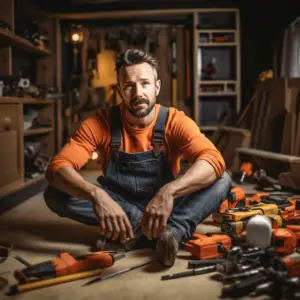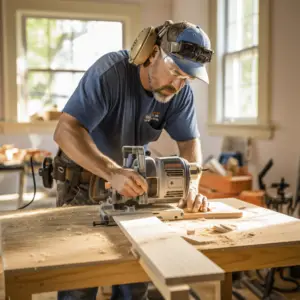Home improvement projects can be thrilling, but also risky. Let’s explore how to stay safe while working on them! If you’re doing a simple DIY job or a complete renovation, safety must come first.
Evaluate the task at hand. Identify potential dangers, like loose wires, sharp tools, or unstable structures. Research and learn the skills and knowledge necessary before you start. This will give you confidence and reduce the risk of accidents or injury.
Protective gear is a must. Safety glasses protect your eyes from debris or chemicals. Gloves shield hands from cuts, bruises, or chemical exposure. Don’t forget respiratory protection if there’s dust, fumes, or other particles in the air. Prioritize safety over style and equip yourself properly.
Your workspace should be neat and tidy. Keep tools and materials away when not in use. This lowers the risk of tripping or causing damage with misplaced items. Good lighting is also essential for visibility and preventing mistakes that could lead to injury.
The National Safety Council found that almost 130,000 emergency room visits yearly are due to injuries from home improvement projects. So it’s essential to prioritize safety before starting.
Be prepared and be aware of the potential hazards. Wear protective gear, maintain an organized workspace, and be mindful. Nothing is more valuable than your well-being. Work smart, stay safe, and enjoy the rewards of your home improvement journey.
Table of Contents
Safety Precautions before Starting the Project

Safety when doing home improvement is top priority. Follow these six guidelines to minimise risk of accidents and injuries:
- Wear safety gear like goggles, gloves and strong shoes.
- Inspect tools and equipment for damage before using.
- Read and understand instructions provided by manufacturers.
- Ensure workspace is well-lit.
- Remove clutter, debris and obstacles.
- Disconnect power sources when handling electrical wiring or using power tools.
Also, don’t rush through projects. Take your time to work carefully and keep accidents away.
A friend of mine once did a DIY bathroom renovation without safety measures. He didn’t wear gloves while handling tiles and cut his hand. It showed him the importance of safety measures before starting any home improvement project.
If you stick to these safety recommendations and learn from experiences, you can have a secure environment while doing DIY ventures. Stay safe!
Safe Handling of Tools and Equipment
Safety is super important when tackling those home improvement projects. Mishandling tools can cause accidents or injuries, so keep these key tips in mind:
- Make sure to wear the right safety gear, like gloves, goggles, and helmets.
- Inspect your tools regularly to ensure they’re in good condition. Faulty tools should be fixed or replaced fast.
- Handle sharp tools with care and store them out of reach of kids and pets.
- If you’re using power tools or machinery, understand the operation manuals and follow manufacturer’s instructions.
- Stay focused while handling tools. Don’t let distractions compromise your safety or the quality of your work.
A tidy workspace is also important. Clean up debris, organise tools in designated areas, and keep pathways clear.
To illustrate the importance of safe tool handling, let me tell you a story. My friend David was doing a DIY project at home when he lost grip of his power drill. It fell onto his foot and caused a painful injury, requiring medical care. This incident is a reminder to always prioritise safety when using tools.
By following proper tool handling techniques, you’ll protect yourself while working on home improvement projects. Stay cautious and stay safe!
Electrical Safety
- Inspect the Electrical System to guarantee it meets the code, is grounded properly, and has the right circuit breakers.
- Additionally, use Ground Fault Circuit Interrupters (GFCIs) in areas where there is water, like bathrooms, kitchens, and outdoor outlets.
- When using electrical tools, be sure to disconnect them from the power source before you clean or adjust them to avoid electric shocks.
- Spread the electrical load across circuits and don’t plug a lot of devices into one outlet.
- Stay alert and check for frayed or broken wires.
- Never touch electrical equipment with wet hands.
- Keep any flammable items away from electrical appliances.
- Learn about basic electrical principles.
- For complex electrical issues, get aid from a certified electrician.
Working with Chemicals and Materials
Working with chemicals and materials is essential for many home improvements. It is key to handle them securely to evade accidents and health risks. Here is a table that shows details about the chemicals and materials used in home improvement projects:
| Chemical/Material | Safety Precautions |
|---|---|
| Paint | Put on protective gloves, goggles, and a mask |
| Adhesives | Work in a well-ventilated space |
| Solvents | Stay away from open flames and sparks |
| Wood Dust | Wear a dust mask and goggles |
| Asbestos | Employ a professional for removal |
| Electrical Wiring | Switch off the power before working |
Apart from the safety steps mentioned, it is important to store chemicals in their original containers with clear labels. Keep them out of children and pet’s reach. Next, always obey the instructions provided by producers on how to use the chemicals or materials. If using unfamiliar substances, investigate their potential risks and safety rules beforehand.
Also, have proper ventilation while using chemicals or materials that release fumes. Open windows or use fans to disperse possible dangerous vapors. Lastly, it is essential to wear the correct protective equipment (PPE). Gloves, goggles, masks, aprons, and strong footwear protect against spills, splashes, inhaling fumes, and other potential risks.
By following these precautions, you can reduce the risks related to working with chemicals and materials during home improvement projects. Prioritizing safety ensures a smooth and accident-free experience while achieving your desired results.
Preventing Falls and Injuries
When working at heights, use a stable ladder or scaffolding. Secure rugs and mats to avoid tripping. Wear protective gear like gloves, goggles, and hard hats. Keep work areas lit up to reduce accidents. Follow proper lifting techniques to avoid strains and sprains. Keep kids and pets away from construction zones.
Be aware of potential dangers too. Check for loose floorboards or wires that may cause falls. My friend Dave didn’t take safety measures when working on his roof. He fell and broke his leg. It was a painful lesson – safety measures are important.
Dealing with Emergencies

Emergencies can strike anytime! It’s key to be ready. Here are some essential tips to keep in mind:
- Having a first aid kit prepared is a must. Include basics like bandages, ointment, and medicines.
- If someone gets hurt, don’t wait – call for help straight away. If it’s serious, dial emergency services.
- Know where the main switches are in case of fire or electricity issues. Learn how to switch off gas, electricity, and water if needed.
- When working with flammable materials (e.g. solvents), always have a fire extinguisher close by. Make sure it’s working and you know how to use it.
- Wear protective gear like goggles, gloves, and helmets when doing risky tasks.
- Stay organized and keep the workspace clean. Clutter can raise accident chances, so tidy up and remove any hazards.
Stay calm and prioritize safety during emergencies. No matter how careful, accidents can still happen. Preparing for unforeseen circumstances is key.
Last September, Mark was renovating his garage alone. Then, he hit an exposed electrical wire while drilling a wall. Sparks flew and a small fire began. He remembered the emergency tips he read about. Without fear, he grabbed the fire extinguisher and put out the fire. He shut off the electricity. He was able to handle the emergency thanks to his wisdom and readiness. This incident taught us how important it is to be aware and prepared for unexpected situations during home improvement projects.
Conclusion
Home improvement projects can be exciting and rewarding, but safety should always come first. Wear protective gear such as gloves, safety goggles, and hard hats. Educate yourself on the safety risks of your project. Take caution and patience with each task. And don’t forget to take breaks. Here’s the story of Jack – an avid DIYer who didn’t follow safety protocols and ended up with serious injury and medical bills. Let’s make sure the same doesn’t happen to us!
Frequently Asked Questions
FAQ 1:
Q: What are some general safety precautions to follow while working on home improvement projects?
A: Some general safety precautions include wearing protective gear such as gloves, goggles, and helmets, following manufacturer instructions for tools and equipment, working in well-ventilated areas, and keeping a first aid kit handy.
FAQ 2:
Q: How should I handle power tools safely?
A: When using power tools, make sure to read and understand the user manual, wear appropriate protective clothing, avoid wearing loose clothing or jewelry that can get caught in the tool, keep a firm grip on the tool, and disconnect the power source before making any adjustments.
FAQ 3:
Q: What precautions should I take when working with ladders?
A: When using a ladder, make sure it is stable before climbing, place it on a level surface, never stand on the top two rungs, keep your body centered on the ladder, and avoid overreaching or leaning to maintain balance.
FAQ 4:
Q: How can I prevent electrical hazards during home improvement projects?
A: To prevent electrical hazards, turn off the power supply to the area you are working on, use a circuit tester to ensure outlets are not live, avoid touching electrical wires with wet hands, and never attempt electrical work if you are unsure or unqualified.
FAQ 5:
Q: What should I do in case of an emergency or injury?
A: In case of an emergency or injury, immediately stop working and assess the situation, administer basic first aid if necessary, call for medical assistance if needed, and report the incident to the appropriate authorities or supervisor.
FAQ 6:
Q: Are there any safety considerations specific to certain home improvement tasks?
A: Yes, certain tasks such as asbestos removal, lead paint removal, or working with chemicals require specific safety protocols. It is important to research and follow the recommended safety guidelines for each task to minimize risks.